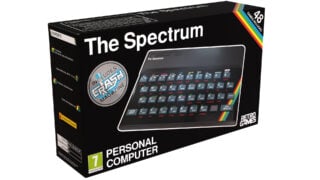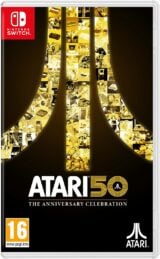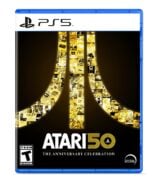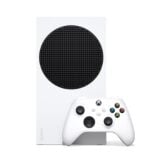HANDS-ON: The Spectrum is a modern love letter to an 80s computer legend, rubber keys and all
Retro Games’s latest old-school revival is Sinclair’s iconic creation

When I was invited to meet up with Retro Games at Gamescom, I was simply being told I was going to see a new piece of “retro hardware” based on a British computer.
If you’re not familiar with Retro, the company has previously been responsible for modern recreations of the Commodore 64 (with The C64 Mini and The C64, the latter featuring a fully working keyboard), the Commodore Amiga (with The A500 Mini) and the Atari 400 (with The 400 Mini).
Given what it had done with the C64, I was expecting to be met with a larger A500 with a working keyboard but instead, when the meeting room door was opened, there on the table was a ZX Spectrum 48K. Or, at least, something that looked very much like one.
I nearly had a wee stumble there and then. For some readers the sight of a Spectrum sitting on the desk may be met with a shrug of the shoulders, but for a certain generation Clive Sinclair’s computer was their first gateway to the world of games.
Full disclosure: I was very much a Spectrum boy in the early days of my life. My dad had a ZX Spectrum 48K – the model being replicated by Retro Games – and many of my early childhood memories were formed by it. I learned to read thanks to a game called ABC Lift-Off, I was obsessed with Manic Miner and I once made smoke come out of the power brick by playing Bear Bovver too much.
My dad also reliably informs me that on many a night he would get his work friends over and they would spend late-night sessions playing Football Manager while I lay in the crib next to the telly. Make no mistake, the Scullions were a Spectrum household.
This carried over to my adult life too. Indeed, when my daughter was 2 or 3 and would cry inconsolably, I would often pull up a YouTube video of Match Day II gameplay because the little chiptune version of When the Saints Go Marching In would have her beaming from ear-to-ear. But I digress.
“I have to stop you before you say anything,” I told the Retro Games developers when I walked into the room. “Does it have rubber keys?”
“Feel them,” they replied. I can indeed confirm that they were rubber, and they felt perfect.
There have been a number of attempts to resurrect the ZX Spectrum over the years, but each have had their own pros and cons.
Back in 2015, the now-defunct Retro Computers (not related to Retro Games) had a go with the ZX Spectrum Vega, a strange mini device with just four rubber keys on it that had to be held in the hands and plugged into the TV with a low quality composite cable.
The ZX Spectrum Vega+ attempted to go one further and turn the Vega into an actual handheld with a screen, but a complete shambles at Retro Computers which led to “irreconcilable differences” between the team, the pulling of developer support and a suspension of its Indiegogo campaign meant only a handful made it to the public before the company went under.
More successful is the ZX Spectrum Next, an all-new computer released in 2017 which offers compatibility with Spectrum games and hardware, using FPGA tech to not only replicate the Spectrum’s inner workings but build on them with extra power and the like. It’s a great piece of kit – I own one myself and love it – but at a few hundred pounds it’s very much a specialist device.
With its attempt, simply named The Spectrum, Retro Games is hoping to hit that sweet spot of something that provides accurate Spectrum emulation but at a more affordable price of £89.99 / €99.99 and with the usual quality of life features its previous devices have offered.
The Spectrum: built-in games
- Alien Girl (Skirmish Edition)
- Ant Attack
- Army Moves
- Auf Wiedersehen Monty
- Avalon
- Bobby Bearing
- Cosmic Payback
- Devwill Too ZX
- Exolon
- Fairlight
- Firelord
- Football Manager 2
- Freddy Hardest
- The Great Escape
- Head Over Heels
- Highway Encounter
- The Hobbit
- Horace Goes Skiing
- Jack the Nipper
- Knot in 3D
- The Lords of Midnight
- Manic Miner
- Match Day II
- Movie
- Nodes of Yesod
- Penetrator
- Phantis (Game Over II)
- Pheenix
- Pyracurse
- Quazatron
- Robin of the Wood
- Saboteur! Remastered
- Shovel Adventure
- Skool Daze
- Snake Escape
- Spellbound
- Starquake
- Starstrike II
- El Stompo
- Stonkers
- Target: Renegade
- TCQ
- Technician Ted – The Megamix
- Tenebra
- Trashman
- The Way of the Exploding Fist
- Wheelie
- Where Time Stood Still
For starters, as previously noted, the company is skipping the Mini version this time around and going straight for a version with a full working keyboard. I didn’t have an actual ZX Spectrum 48K to hand so I couldn’t compare them both, but the new version appears to be a little smaller. Those beautiful rubber keys are still there, however, and so is the iconic rainbow stripe on the bottom-right corner.
The device is USB-powered and offers 720p output via HDMI, and has a total of 48 games pre-installed, some of which are the very best the Spectrum had to offer back in the day. Manic Miner, The Hobbit, Horace Goes Skiing, Skool Daze, Auf Wiedersehen Monty, Head Over Heels, Saboteur! Remastered and yes, even Match Day II, they’re all on there along with some modern homebrew releases designed to show off the limits of what the Spectrum was able to pull off.
Naturally, given that there were tens of thousands of Spectrum games released over the years (when you count full releases, compilation games, homebrew, and the ones you had to type in from magazine listings), 48 titles barely scratches the surface. That’s where the USB stick support works, allowing you to play any of your Spectrum ROMs (“legally acquired, of course,” Retro Games stresses with an immaculate poker face).
The device supports numerous Spectrum game formats including .tap, .tzx, .z80 and more. Depending on which versions you use this means you can either load up a ‘snapshot’ of the game that starts immediately at the title screen, or if you’re a purist you can load a cassette tape image and play the entire lengthy loading routine (complete with screechy noise) you used to get back in the good old days. If you want a middle ground The Spectrum can also speed up the loading process for certain formats.
While The Spectrum’s design is clearly based on that of the rubber-keyed 48K, it can emulate all models of the hardware – the 16K, 48K, Spectrum+ and 128 – meaning if you have games that required 128K of memory back in the day you can still play them here.
“While The Spectrum’s design is clearly based on that of the rubber-keyed 48K, it can emulate all models of the hardware – the 16K, 48K, Spectrum+ and 128 – meaning if you have games that required 128K of memory back in the day you can still play them here.”
Other quality of life features include your typical save state, resizing, border and rewind options, as well as the option to trim the display for games that had a large colour border around the edges. 50Hz and 60Hz support also ensures all those PAL-developed games run at the speed they were supposed to back in the day.
The final thing that needed to be addressed during my meeting was that of controls. Because the ZX Spectrum 48K didn’t come with a joystick, The Spectrum comes with the main unit and the required cables, with no controller included. Every game can naturally be played with the keyboard, but anyone who wants to kick things up a notch can plug in a USB controller, with support for a wide selection of pads and sticks.
Given that the vast, vast majority of joystick-supported Spectrum games only had one fire button, many of them used Up to jump. If this feels awkward, Retro Games has added a control mapping option, which lets you reassign or duplicate commands to various buttons.
In theory, then, assuming a wired Xbox controller works, you can assign it so that the A button acts as the joystick’s Fire button, but then assign a duplicate Up command to the B button, meaning you can use it as an alternative jump button.

As my final nerdy question, I decided to see if Retro Games truly had thought of everything. Any Spectrum fan worth their salt will remember that the computer had three main joystick interfaces, and not every game supported them all.
“So when you plug in a controller,” I asked the team, “what does it assign it as? Kempston, Cursor or Sinclair Interface 2?”
“Good question,” they replied, bringing up a menu. Sure enough, when you plug in a controller, you can decide which of the three main interfaces it represents, so if for example a game supports the Kempston interface (the most common one), you can set it to that.
Pre-orders for The Spectrum are already available now, and the device will release across Europe on November 22 for £89.99 / €99.99 (a US release has yet to be confirmed).
I’m itching to get hands-on with the final device and really put it through its paces – so far the signs are all looking promising, but things like compatibility for external games via USB will have to be extensively tested before this can be considered definitive. Watch this space for a full review nearer to release.











